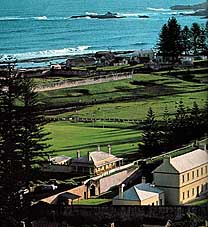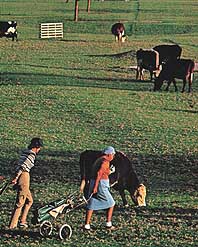The mutiny on the Bounty is the most famous of all
mutinies at sea; and it was probably the most gentle, although three of the
mutineers were eventually hanged from the yardarm of a Royal Navy ship in
Portsmouth Harbour.
 Quality
Row, military barracks in Norfolk’s dreaded penal colony until 1856 when the
island was turned over to the Pitcairners
Quality
Row, military barracks in Norfolk’s dreaded penal colony until 1856 when the
island was turned over to the Pitcairners
Bligh wasn’t a monster, although he was an authoritarian
captain with a quick temper and a bitterly sharp tongue. As Bligh left Tahiti
in April 1789 with its cargo of breadfruit plants, he called his crew
“damned thieving rascals” and vowed to drive them mercilessly on the hard
voyage ahead. On April 27
No drop of blood was shed. The mutineers put Captain Bligh
and his 18 loyal crew members into a boat, with enough food and equipment to
give them a chance to survive and set them out to sea. The mutineers returned
to Tahiti, and with a handful of Polynesians, finally sailed to an uninhabited
island, mischarted on the map, called Pitcairn. They burned the Bounty
and stayed. They were the first Pitcairners.
In the vastness of the Pacific a sprinkling of islands
forms the Polynesian triangle, some 15 million sq. miles in area. Hawaii is at
the apex, Easter Island at the lower right-hand vertex, New Zealand at the
lower left. The Pitcairners today inhabit two widely separated islands near
the eastern and western tips of the triangle. Pitcairn looms up like a
tattered grey ruin of a fortress. There is no safe harbour. That is one of the
reasons the mutineers chose the island. Life is hard for the descendants of
the Polynesians and crew members of the Bounty. They are farmers and
herders on a windswept rock at the furthermost reaches of the world.
 The
occasional stray cow on Norfolk’s golf links is not a handicap
The
occasional stray cow on Norfolk’s golf links is not a handicap
Norfolk Island is a second home to the descendants of the Bounty
mutineers and shares their legacy. The entire population of Pitcairn was moved
here in 1856 when that island became overcrowded. A few families returned to
Pitcairn, but most stayed on to settle the 13,000 sq. mile territory of
Australia. Queen Victoria gave the Pitcairners Norfolk Island, a former penal
colony with a black reputation. Today an airstrip links Norfolk to a faster
paced Australian society, but life on the island remains slow.
The Pitcairners use their own language, developed from a
combination of Polynesian and mangled English, but of course they will speak
English to visitors. They want guests to feel welcome. It is mainly a farming
community, but new settlers and vacationers from Australia have allowed its
somewhat frugal economy to grow. Both islands retain a bucolic tempo as
inhabitants strive to preserve the legacy of the Bounty.